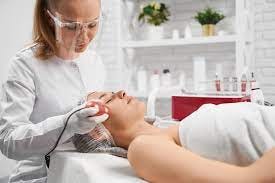The beauty industry has witnessed tremendous growth in recent years, and one of the major drivers of this growth has been the increasing popularity of non-invasive cosmetic procedures. Medical aesthetic devices have played a significant role in this trend, with advancements in technology leading to more effective and safer treatments. Here are five types of medical aesthetic devices that are transforming the beauty industry:
The global medical aesthetic devices market was valued at $13,529.65 million in 2020, and is projected to reach $38,916.60 million by 2030, growing at a CAGR of 10.7% from 2021 to 2030.

- Laser and light-based devices: Laser and light-based devices use intense pulsed light (IPL) or laser energy to target specific areas of the skin, such as hair follicles or pigmented spots. They are used for a wide range of treatments, including hair removal, skin rejuvenation, and acne treatment.
- Radiofrequency devices: Radiofrequency devices use radiofrequency energy to heat the deeper layers of the skin, stimulating collagen production and tightening the skin. They are used for treatments such as skin tightening, body contouring, and cellulite reduction.
- Injectables: Injectables are products that are injected into the skin to fill in wrinkles or add volume to certain areas, such as dermal fillers or Botox. They are used for treatments such as wrinkle reduction, lip enhancement, and cheek augmentation.
- Microdermabrasion devices: Microdermabrasion devices use fine crystals or a diamond tip to remove the top layer of dead skin cells, revealing smoother, more youthful-looking skin. They are used for treatments such as skin exfoliation, scar reduction, and stretch mark reduction.
- Body contouring devices: Body contouring devices use various technologies to reduce the appearance of cellulite, tighten loose skin, or eliminate unwanted fat. They are used for treatments such as fat reduction, skin tightening, and cellulite reduction.
Several factors can impact the Medical Aesthetic Devices Market. Some of the key factors include:
- Demographics: As the population ages, there is an increasing demand for non-invasive cosmetic procedures to address age-related concerns, such as wrinkles and sagging skin.
- Technological advancements: The development of new technologies and devices that are more effective, efficient, and less invasive can drive demand for medical aesthetic devices.
- Disposable income: The disposable income of individuals can impact demand for medical aesthetic devices. As incomes rise, more people may be able to afford these types of treatments.
- Consumer awareness: The awareness and acceptance of non-invasive cosmetic procedures are increasing, which can lead to more people seeking out these types of treatments.
- Regulations: Regulations surrounding the use of medical aesthetic devices can impact the market. Tighter regulations can limit the availability or increase the cost of these devices.
- Competitive landscape: The level of competition among manufacturers and suppliers of medical aesthetic devices can impact market growth and innovation.
The Medical Aesthetic Devices Market can be segmented based on the type of device or treatment. Some common segments include:
- Laser and Light-Based Devices: These devices use laser or light energy to target specific areas of the skin, such as hair follicles or pigmented spots.
- Radiofrequency Devices: These devices use radiofrequency energy to heat the deeper layers of the skin, stimulating collagen production and tightening the skin.
- Injectables: These are products that are injected into the skin to fill in wrinkles or add volume to certain areas, such as dermal fillers or Botox.
- Microdermabrasion Devices: These devices use fine crystals or a diamond tip to remove the top layer of dead skin cells, revealing smoother, more youthful-looking skin.
- Body Contouring Devices: These devices use various technologies to reduce the appearance of cellulite, tighten loose skin, or eliminate unwanted fat.
- Others: This includes other devices or treatments that may be used for specific purposes, such as acne treatment or scar reduction.
The Medical Aesthetic Devices Market refers to the industry that develops and sells equipment and devices used in non-invasive or minimally invasive cosmetic procedures. These procedures are meant to enhance or improve the appearance of the skin or body, such as reducing wrinkles or removing unwanted hair. The market includes a wide range of products, including laser and light-based devices, radiofrequency devices, and injectable products. The market has grown significantly in recent years as more people seek out these types of treatments.
In conclusion, medical aesthetic devices are revolutionizing the beauty industry, offering patients more effective and safer treatments than ever before. With advancements in technology and increasing consumer awareness, the market for these devices is set to continue growing in the years to come.
0 Comments